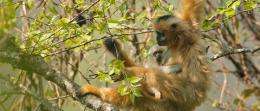Extinction looms for gibbons in Vietnam, scientists say

The first comprehensive study of gibbons in Vietnam in over a decade has found that three of the six species (the cao vit and western black crested gibbons and the northern white-cheeked gibbon) are perilously close to extinction, and the remaining three have suffered massive population declines.
The report, The Conservation Status of Gibbons in Vietnam, co-authored by Fauna & Flora International (FFI) and Conservation International (CI), was released today. It details the population declines that Vietnam’s gibbon species have suffered over the last 10 years.
Gibbons have now disappeared from much of their historical range in Vietnam, and the few remaining viable populations are restricted to protected areas that in almost all cases lack the standard of protection needed to ensure their survival.
Hunting and habitat loss have driven these dramatic recent declines. Even within protected areas, illegal logging, agricultural encroachment and infrastructure developments (such as hydropower dams) are eroding away key gibbon habitat, while new roads are making it easier for hunters to access the forest.
Habitat loss also causes population fragmentation, leading to ever smaller and more vulnerable subpopulations.
“To thrive, gibbon populations need relatively large tracks of reasonably intact forest and this is increasingly rare in Vietnam,” said Dr. Ulrike Streicher, Wildlife Veterinarian, Primate Programme Manager, FFI Vietnam. “Although we have seen some local success in gibbon conservation (for example at the Cao Vit Gibbon Conservation Area in Cao Bang Province), a lot more still needs to be done.”
The bigger picture
Poor awareness and understanding of the plight of gibbons in Vietnam is also contributing towards their decline.
“The general public and local stakeholders (especially local government) need to be more aware and supportive of protecting these Critically Endangered animals,” said Ben Rawson, CI’s Regional Primatologist for the Greater Mekong Programme and Coordinator of the Primate Specialist Group, Indochina.
The report’s findings are merely the tip of the iceberg, flagging deeper and more widespread threats to much of Vietnam’s biodiversity and natural environment.
“The geography of Vietnam lends itself to an extraordinary level of biodiversity, and the diversity of gibbons is no exception,” said Paul Insua-Cao, FFI Project Manager for Gibbon Conservation in Laos and Yunnan, China. “Regrettably, the many threats they face in Vietnam are shared by much of the rest of the country’s precious wildlife.”
“Gibbons are now commonly being reported as locally extinct in Vietnam,” said Nguyen Manh Ha, researcher at the Centre for Natural Resources and Environmental Studies (CRES), Vietnam National University. “Unless we take urgent action, our next generation will not have the opportunity to see gibbons in their natural habitat.
“These are wonderfully charismatic and gentle creatures, which do not harm anyone’s livelihoods, but charm us with their beauty, acrobatics and songs. They are humankind’s closest relatives in Vietnam. If nothing can be done to secure their long-term future, what hope is there for the rest of Vietnam’s biodiversity?”
More information: Report: www.fauna-flora.org/wp-content … bbons-in-Vietnam.pdf
Provided by Fauna & Flora International


















